to the index page
Seeking a glimpse of legends from the Days of Sail when great men built boats of Nova Scotia timber and rode out to the Atlantic on huge Fundy tides, we went twenty-six-hundred miles in a little rental chevy with a leaky tire and a full load of camping gear, from Boston up to Yarmouth and around through New Hampshire and New York to visit family and friends. The colors were nice, there was snow, apple cider and donuts, maple syrup, Digby scallops and fresh Maine lobsters pulled from the sea just hours earlier, tender sweet things despite their appearance as spiny slimy giant sea insects. Pumpkin pie and hot cider herald the coming of winter but the chill in the air practically shuts down the towns to tourists. In another week or two, almost everything will be closed.
October 2009
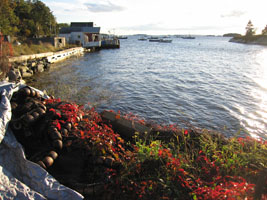
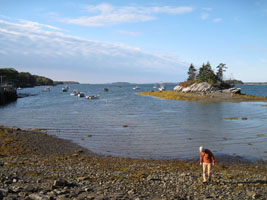
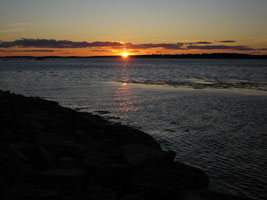
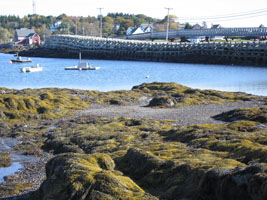
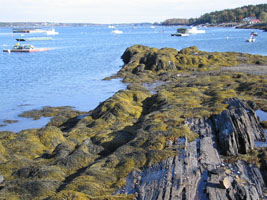
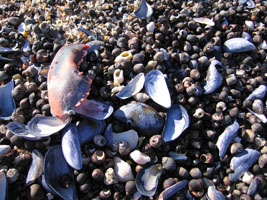
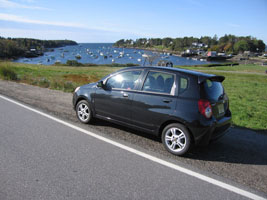
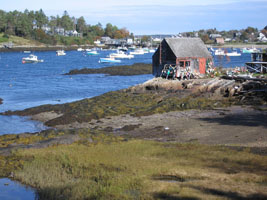
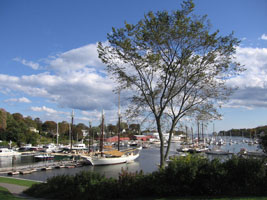
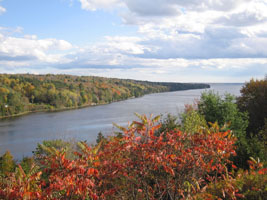
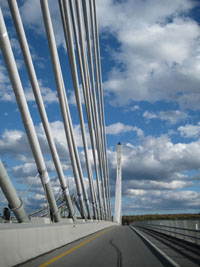
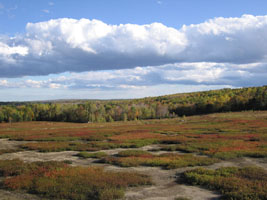
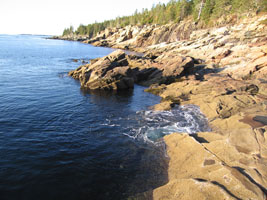
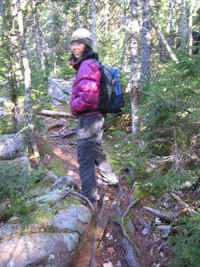
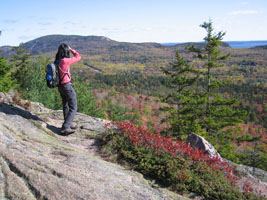
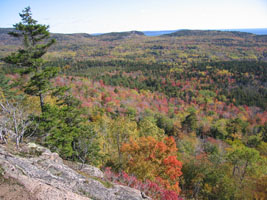
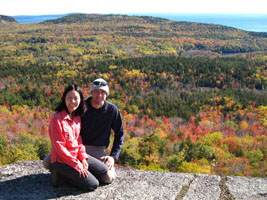
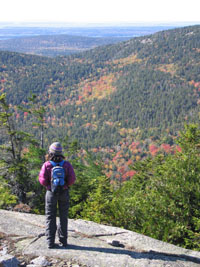
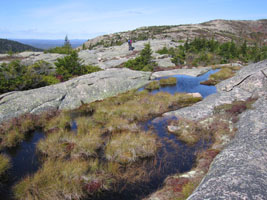
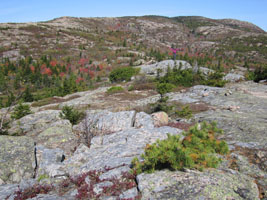
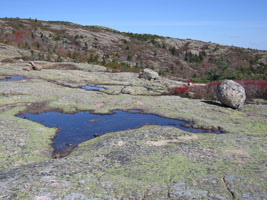
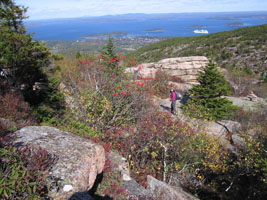
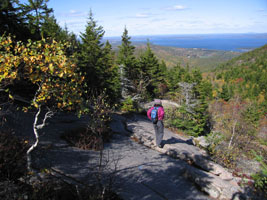
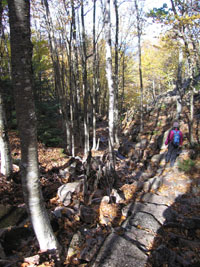
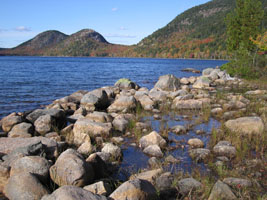
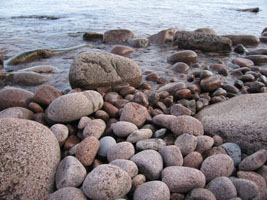
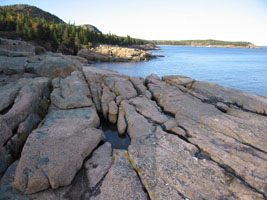
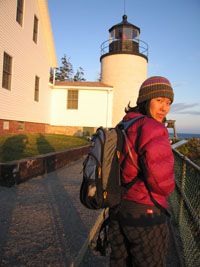
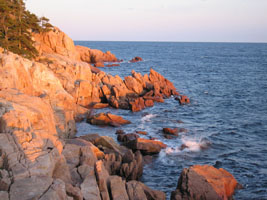
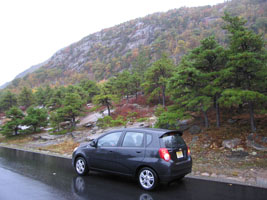
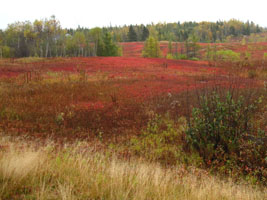
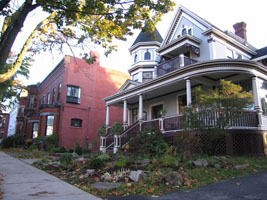
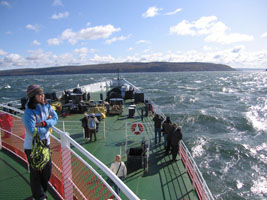
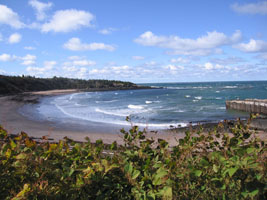
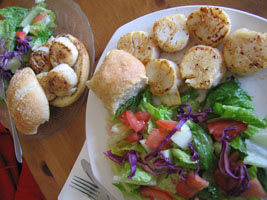
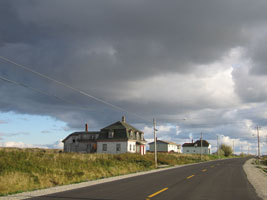
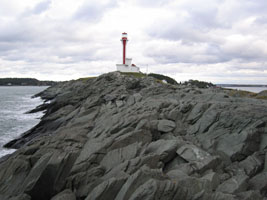
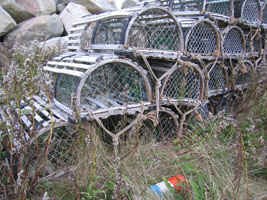
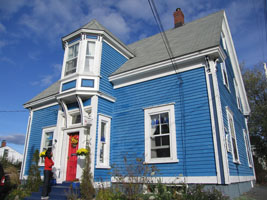
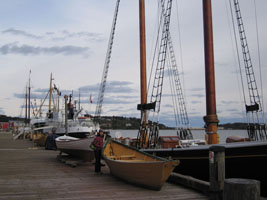
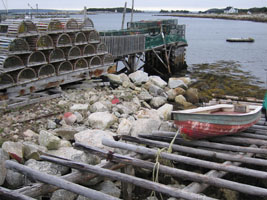
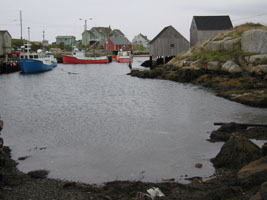
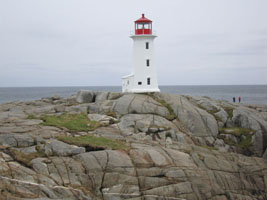
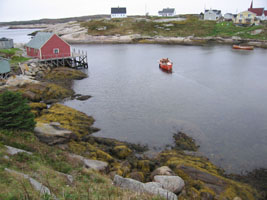
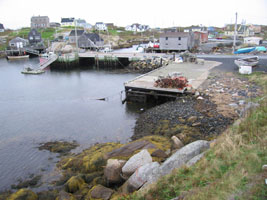
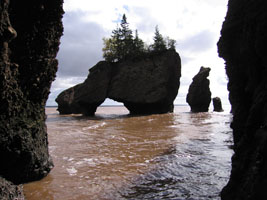
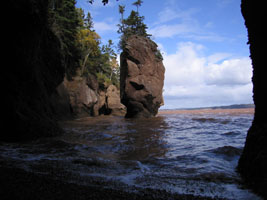
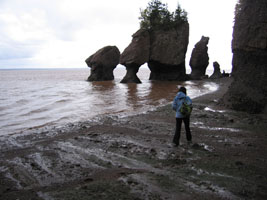
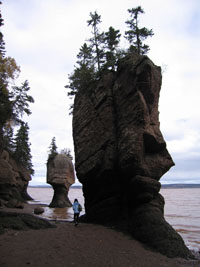
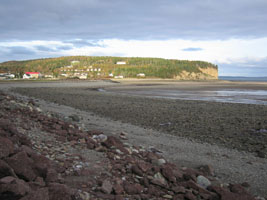
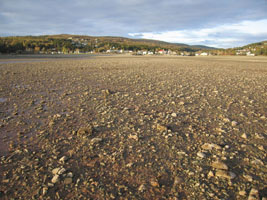
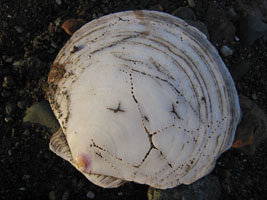
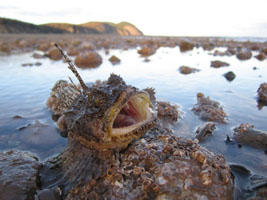
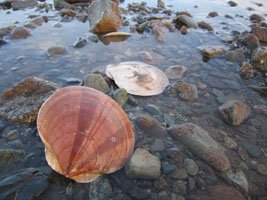
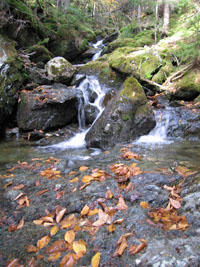
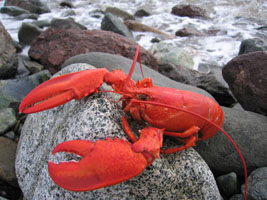
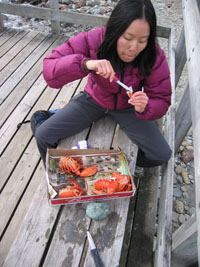
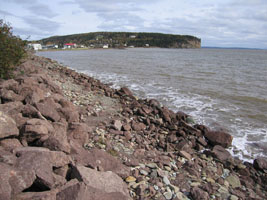
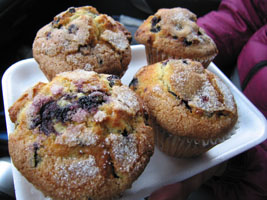
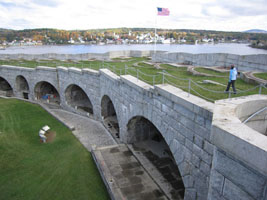
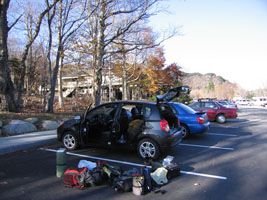
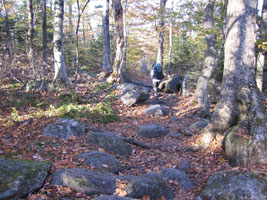
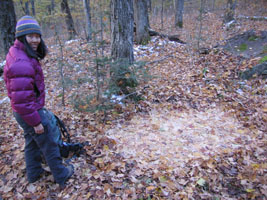
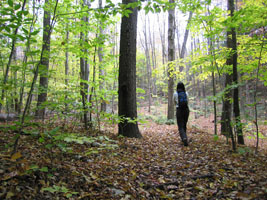
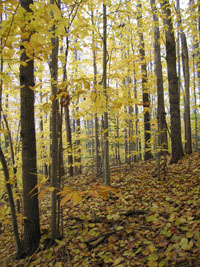
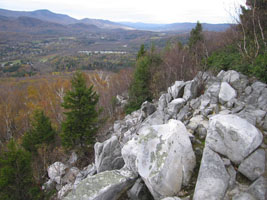
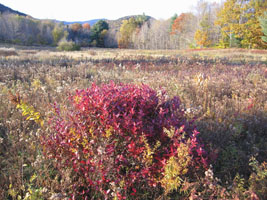
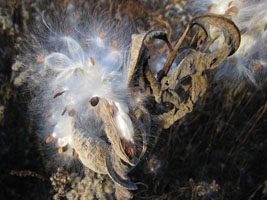
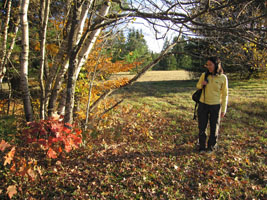
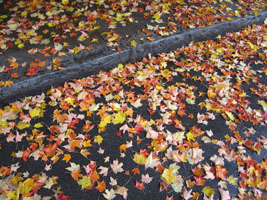
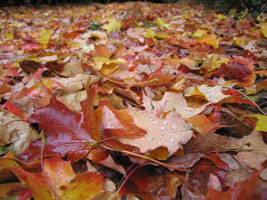
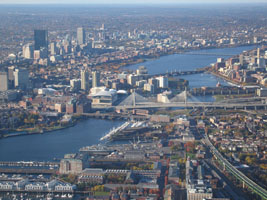
This was to be our first real vacation since we moved in together. It had been almost a year since I left my old job in Pasadena and made the long trip north to San Mateo, and I was settled in at work and ready for a break. For several years I had been wanting to make a New England tour in October so we bought tickets to Boston and planned a meandering journey.
I rented a tiny Korean car that barely held our bags stuffed full with camping gear and clothes. It was so small and light that when the dashboard indicator lit up with a low tire pressure warning on the second day, I couldn't tell which tire was flat. Even with the tire at ten psi most of the time (on account of a nail in the sidewall, in one of the rear tires) the car looked and handled just fine and we drove it that way all through the trip, topping up the air every day or two, because no tire shop from Portland to Halifax even dreamed of carrying aftermarket Asian tires. I would pick up the phone, get half way through reading the tire part number, and hear an abrupt "no, we don't carry those" along with a tone of voice that suggested "son, where do you think you are? Around here, people drive big capable vehicles made for working in the mud and the ice, and we let that street racer riff-raff get stuck in a ditch and tow home!"
In Boston on a fine autumn morning, with the ground slicked by rain-soaked colored leaves and the sky clearing to blue with cottonball clouds, euphoria took hold of my day. Coasting up open roads in the early morning, we admired the fall foliage. Our first stop was at an old restored iron foundry in Saugus that Joy found, a park with a small museum and reconstructed blast furnace from the early colonial days. Back then, people knew how to identify suitable iron ore and other minerals and could make iron in the woods if allowed a suitable site with wood, water to run mill wheels for trip hammers, and nearby ores. I wonder today how many people could do the same, making low-grade iron if given a rock hammer and an axe and not much else. Fortunately, even if some global catastrophe renders our mine and mill infrastructure useless, we will have enough metal junk around to last a very long time.
Our destination for the evening was Harpswell, Maine, a ways up the coast past Freeport. We stopped twice along the way, first for lunch in Portsmouth, New Hampshire where in the quaint center of town we ate hot soup and freshly baked popovers, and then in Freeport for a bit of shopping at the outlets. The LL Bean store, with it's giant boot sculpture outside and indoor aquarium stocked with trout, stunned me with it's volume and variety of goods. Of course I've seen plenty of gear in my years of browsing outdoor sport stores, but this was everything in one place: hunting gear, fishing equipment, and things for car camping as well as backpacking. The only thing I really wanted was the old wooden frame of a sea kayak that hung from the ceiling. Actually, I just wanted to build one myself. It was beautiful, lean and flexible, efficient and strong.
After browsing shops for a while, late in the afternoon we stopped for a snack at a coffee shop in Portland where we bought mulled cider and pumpkin coffee. Joy's cider was nice but my pumpkin coffee wasn't really very good, and I advise that you keep pumpkin pie and coffee with cream sequestered in separate containers. Showing restraint, I did not buy a big chocolate whoopee pie, that wonderful creation of the Pennsylvania Dutch that is almost unknown in the American West. I regret passing up that opportunity, so much that now when I travel back East I am always on the lookout for these fresh baked pastries at village general stores and cafes.
It was just as well, however, that I saved my appetite because on the way to Harpswell we passed another thing I miss out West - an old table at the bottom of a driveway with bags of fresh picked apples and a can for money. I bought a bag of crisp Cortlands, crunchy and white with bright red skin, firm but not hard, and slightly tart, the way an apple should be. We checked into the cozy Harpswell Inn and walked down to the water where the tide was high.
A ways farther down the road, towards the end of a narrow peninsula on this island-packed section of coastline, we pulled into a restaurant where cooked lobsters with butter were two for twenty dollars. They don't get any fresher than we had them, and I could taste the difference in the bright, sweet meat that was swimming in the sea just a short while earlier.
How these big sea insects survive is remarkable when one considers the number of lobster traps moored in inlets and bays offshore. The open season rotates around from one area to another so fishing is not continuous, and there are size limits for catch, but it takes five years to grow a lobster (and they'll live to fifty!) and I wonder how there can be enough of the critters left untrapped at the end of the season.
The sun sank below the horizon as we finished our meal in the restaurant. Stuffed with food, tired from our travels, and ready for sleep, we returned to the inn and called it a night.
Breakfast was waffles or eggs cooked to order, included with our room rate. Downstairs in the lobby there were shelves overflowing with books, jigsaw puzzles, and board games. It would be a nice place to sit by the fireplace on a stormy day. We, however, were moving on. It was time to venture forth into the wild and do some camping in Acadia.
Around ten am we noticed the low tire pressure warning light on the dash, but it went away as the day warmed up. This was the start of our two-week-long love affair with quarter-operated air pumps. We took a drive down another peninsula to see more of the countryside, thinking we might reach open sea, but even there at the end of the road there were more outlying islands and only small waves lapping on shore. It was pretty nonetheless, and I was intrigued by a cribstone bridge, basically a bridge made out of granite Lincoln Logs. These were stacked like sticks of wood to raise the road bed about fifteen or twenty feet while letting water through. It was an ingenious use of local material to withstand the tides and storms, and the construction type is so rare that I'm not sure whether "cribstone" describes any other bridge in the world, or just this one.
It was lobster for lunch, again, in the postcard-pretty town of Camden where a few tall ships are anchored and a rugged hillside rises behind the town. Its rocky crags and brilliant orange foliage contrasted nicely with the white church steeples and elegant homes. I ate a lobster roll and fell in love. None since has tasted quite as good, but I have not yet been back to Maine.
Seeing a flea market happening alongside the road in a field, I pulled aside and we spent a while looking through the usual rummage of tools, household decor, kitchenware, and clothes. One thing caught my eye: an iron mass balance for weighing codfish, with a big hook for hanging the fish and a sliding weight; the whole apparatus was a couple feet long. I negotiated a bit and bought it, thinking I might hang it in the garden shed with a burlap sack for weighing potatoes, onions, etc. It makes an interesting functional souvenir, at least.
We crossed the architecturally grand Penobscot Narrows Bridge but had no time to stop (until our return trip a week later). Acadia was a ways up the coast and we had to buy campstove fuel and groceries. At the small-town general store where I found a gallon of white gas, the owners were just closing up shop for the weekend. We chatted a bit and they spoke with admiration of our close proximity in California to the western national parks, which they had seen recently in the Ken Burns television series. We, on the other hand, were dazzled by their national park: Acadia, at the peak of it's fall color.
We got settled at camp in time to hurry down to the rocky coast and watch the colors of the low sun fade. The sea was remarkably calm, unusual for Acadia. Then darkness fell, and dinner was a subdued affair without much lighting. I should get a lantern for these occasions. We were tired, anyway, and went to sleep early.
Two nights camping allowed a full day on the trails, and it was beautiful - sunny, cool, just like the many days I remember hiking in the Adirondacks in college. After breakfast at the campsite we walked south, following a narrow footpath through mossy spruce forest sprinkled with bright red fallen maple leaves. The short gnarled trees thinned as we climbed higher onto the shoulder of Cadillac Mountain, a treeless rounded summit with spectacular views all around of the blue ocean, distant hills inland, and puffy white clouds in a bright sky. To the southeast, toward the sun, the ocean was steel gray and white. Some hillsides showed brilliant splashes of color though overall the foliage was somewhat muted, with lots of yellow and coppery brown.
We sat on boulders and ate goldfish crackers, sheltered at the summit and made sandwiches for lunch, and paused on cliffs over a sparkling brook to eat apples on the way down. There is an auto road to the top of the highest peak so crowds of people had gathered there with kids and dogs and shopping bags from the gift shop and cafe, where we stopped long enough to buy some postcards. Our route down the western flanks of the mountain was more thickly forested than the exposed eastern slopes had been, with taller trees and more hardwoods. In the blue harbor far below, a big white cruise ship had stopped offshore from Bar Harbor.
Lucky for us, the park shuttle bus that follows a loop around the island was still running; it would close for the season the following day! We had emerged onto the loop road and could catch the bus anywhere as it passed. Concerned about how we would successfully spot, flag down, and board the bus when it appeared around a bend in the narrow road, we walked a ways to find a longer straight section of road with a decent-sized pullout. Would the bus actually come? We waited, assuring each other that since we had walked here, we could walk back, if hitching a ride didn't work either. Once the bus came, just twenty minutes later we were back at camp.
There was time enough to drive across to another arm of the island to see the scenery and watch the sun set by a lighthouse on the southern shore. The ocean was still surprisingly calm, and we could walk out on the rocks below the light to admire the scene along with about a dozen other people, many toting huge camera lenses and tripods. It felt a little crowded. The drive back to camp took a while (one-way roads didn't help) and it was thoroughly dark when we returned. I had bought firewood and we lit a campfire, but the wood was dense and must have been a little green still, because it wouldn't produce hot glowing coals or sustained bright flames. If only wood gathering had been allowed, we would have had a blazing fire in no time.
In the early hours of the morning I woke to the urgent, distant tolling of a bell buoy a few hundred meters offshore near our campsite. The wind had changed and strengthened; new weather was coming in as forewarned by the wispy clouds moving in at sunset. By morning there were bursts of light drizzle and the sky was gray. We packed up early, giving up any plans to linger at camp or climb another small peak. The scenery was still pretty in the mist, but the hilltops were all socked in. Leaving Acadia, we made a stop at the state park just to the north and walked along deserted stony beaches.
Around lunchtime we stopped at a diner for acceptable but unexciting hot food. We were in blueberry country, and the fields of wild lowbush berry plants were brilliant red in their autumn colors, all along the roadside. The Canadian border was not far away. There in town, the old Victorian buildings looked like gingerbread houses with their ornate filigreed wood trim and bright pastel colors. Across the border, however, the landscape quickly became bleak and wild without drama or anything much besides low brown trees set back from the highway cut. This went on for miles, with no sign of the coastline, hills, or villages, and it was rather depressing.
I wanted to visit the Canadian Maritime provinces for a specific reason: to know how it was in the Age of Sail when the oceans were largely uncharted, the Grand Banks were fabulously rich with fish, and men built great wooden sailing ships. Saint John, New Brunswick was once a center of this trade. At the mouth of a deep and powerful river, if had access to stands of timber, water power for sawmills, and a suitable harbor. Even today, it is one of relatively few seaports in the region deep enough for giant cruise liners arriving from New York.
We arrived in town under gray skies later in the afternoon, crossing a high iron bridge over the Saint John River which churned far below in a black rock gorge. It was a little scary seeing such powerful water. Our room for the night was at a cozy Bed and Breakfast in the center of town, in a well kept Victorian style home. It wasn't that late in the evening when we set out to find dinner, but Saint John all but closes down when the cruise ships leave late in the afternoon. New ships arrive overnight, and in the morning they disgorge their passengers on shore. By evening the streets are empty. We chose a nice-looking restaurant with trendy decor and a tantalizing but pricey menu, but it missed my expectations compared to tasty cheap lobster rolls and cafe meals. Everything else was closed when we had finished, so we returned to our room and called it a night.
Under cover of darkness, a giant cruise ship slipped into port at the bottom of the steep hill where we were staying. When I walked outside in the morning, I was startled to see what at first looked like a new high-rise office building towering over the town where a day earlier there had been open air. The ship was so tall that its decks roses level with our hilltop residence and fit in among the taller office buildings down along the waterfront, except unlike the office buildings it had orange plastic lifeboats slung alongside the cabin balconies at regular intervals.
Our hosts prepared a hot breakfast and gave us pointers on how best to drive to the ferry terminal, where we were due to catch an early morning boat across the Bay of Fundy to Digby, Nova Scotia. The trip would take an hour or so. I drove our little car into the ferry and parked among trucks that smelled strongly of fish and diesel fuel. Above, in the passenger cabin, the air was fresh and the views outside were beautiful. We spent most of the trip outside on the forward deck, bundled up against the cool wind, watching the far shore come closer.
Digby is situated in a long slender inlet, near the mouth of a relatively large body of water draining to the sea through a narrow channel. Fundy's four meter tides send an enormous amount of water surging through and when we approached against the tide the entire channel was raised in whitecaps and flowing like a river. The boat's engines increased to full power and we inched ahead into the torrent. On shore, there were just a few buildings and some pretty waterfalls. This far north the leaves were mostly off the trees.
The Bay of Fundy, and Digby in particular, is a rich source of scallops - the big succulent kind that come from shells as large across as your hand. Most grocery store scallops are treated with a stabilizer solution and frozen, leaving them rubbery and with a chemical taste. Fresh scallops, on the other hand, are wonderfully tasty and delicate. We ate them there in town at a restaurant where the cook knew exactly how to prepare them. Down on the docks, freshly caught scallops were being packed into boxes for shipment all over the world.
We explored some back roads around Digby including one where residents were engaged in a battle of signs for and against a proposed wind turbine farm. It seemed shortsighted to me, that out here in the open country with so much space people were so opinionated about the noise and hazard of these machines. They could turn their community into a unique place by doing something different, selling power to their neighbors and marketing scallops to the world as the only fresh wild shellfish packed in a plant powered by wind, that is, snatched straight from the Fundy tides and boxed with blustery North Atlantic winds to arrive fresh at your kitchen with the crisp aroma of sea air almost discernible as you open the box. I'd buy those for a premium price! But almost everyone wants their back yard to remain unchanged from the way it used to be, and there was struggle every inch of the way as the big new Digby Neck wind project got under way.
With the day getting along, I turned the car down the coast toward Yarmouth. That name conjures up visions of seaside cottages, tall wooden ships, and a busy fishing port colored by sailors from all over the world. I was pretty excited about seeing all this. But first, we had to wind our way down the coast through a variety of interesting towns built by European immigrants. One had a big gothic cathedral, out of place in such a tiny settlement; farther along we passed through predominantly French areas where the Acadians settled before packing up and moving to Louisiana where they became Cajuns. If you don't know that bit of history, it seems unbelievable at first.
Not matching my grand expectations, Yarmouth disappointed me. The port is outside town, distant across low-lying open country, and the sea was flat and gray. The town center had some nice old Victorian-style buildings amid new tasteless convenience stores and retail spaces, but all these were away from the coast and overall it looked like any other rural town. It was expensive, too; we had trouble finding a room and then turned down a rather expensive Bed and Breakfast in a nice house, only to regret it later once we had settled for a seedy old motel down the road with thin sheets and very old drab red carpeting.
I decided we should go south at sunset and look for the wild sea vistas I was sure must be around somewhere. Miles of road rolled past, but all we saw was marshes. The gas gauge got unnervingly low. My favorite discovery was a pair of old houses on a windy road outside town, obviously well built with classic architecture and workmanship from a century ago, or more. These were from that Age of Sail that I was searching for, from back when cod was king and this town was a major maritime port.
We had dinner at a little diner out there on a back road, nothing special, and called it a night. The old Yarmouth is gone, if it ever was like I imagined.
In the morning, just to make sure, we drove around to the Yarmouth Light and walked around on the gray rocks by the gray sea. There was nothing there but the old red and white tower, not especially attractive as lighthouses go. It was time to move on.
Things improved from there. The countryside grew more scenic, and we turned inland to visit the Lunenburg County Winery. A big black dog bounded out to greet us at a hilltop farm where we made our way to one of the barns to taste all sorts of fruit wines, like blueberry and blackberry and apple and peach. They were excellent, and the bottles were only twelve dollars! That's a real bargain for boutique wine. It was all made right there, from local fruit; we narrowly missed pick-your-own blueberries since a hard frost turned the berries mushy just a day earlier. The bushes still had quite a lot of fruit on them, a surprise so late in the season. The warm Gulf Stream ocean current keeps the weather mild there.
Having tasted everything and purchased some wine, we drove onward though low country covered with short scrubby trees and boulders. Near Peggy's Cove we stopped to see a memorial to a Swissair flight out of New York that crashed offshore in 1998 after a fire onboard. A short walk from the roadside there is a nice memorial of granite boulders cut and polished with angular faces that align with the impact site offshore in the bay. It was really a beautiful location, with red lichens and mosses and small spruce trees, wild and gnarled, looking out on the ocean.
Arriving next in the postcard-perfect village of Peggy's Cove, we went directly to the lighthouse and walked for a while on the rocks. The sky was gray and the tide was way down but no matter the weather, the red and white lighthouse makes a pretty scene. It is surrounded by attractive granite boulders streaked with ribbons of green grass. The town itself is tiny, home to some fishermen and not too much else. Lobster pots were piled high on shore.
A short ways down the road is Lunenburg, an UNESCO world heritage site on account of it's well-preserved British colonial style. Small, quaint, colorful, and original, Lunenberg was lovely. Tall sailing ships were moored right there on shore, alongside modern fishing boats, and there was an excellent maritime museum where we got to walk around inside some of the ships. This was as close as I came to finding a way back in time. I bought a history book at the museum store, and walked a while through town trying to imagine it back in the early 1800s.
The southern coast of Nova Scotia is mostly east of Boston, not way up north like I am usually inclined to believe. It has a mild climate and close proximity to the fishing banks and the sea routes from Europe, so it saw settlement in the 1600s. They taught us in elementary school about Plymouth Plantation in Massachusetts, suggesting that these people were among the first Europeans to come live on the continent, but by 1620 people had been sailing between Europe and the upper parts of North America for more than 500 years. By the time modern Lunenburg got built in the 1800s it was less of a wild frontier than my imagination had made it out to be.
That might have been true on shore, where they built nice houses and made a well-planned town, but at sea things were different. There was a chapel at the maritime museum where the names of those lost at sea were engraved on a wall, listed by year. 1926 and 1927 were bad years, with dozens of people gone to sea and never returned. Most years had at least a few names, and even recently, every couple years, someone doesn't come home. Imagine sailing out to sea with no way to know that a massive hurricane was pounding North Carolina and on it's way north. Times were different back then. Most sobering of all was seeing multiple family members all gone at once, fathers and sons working together. A community founded on fishing, especially in those early days, must have felt quite different from farming or industrial centers. Imagine being there looking out to sea, waiting for someone to come home. It was eerie.
We looked at a few rooms and selected a Bed and Breakfast at the top of the hill, looking over the town, in a cute blue and white house. Our hosts recommended Magnolia's restaurant a few blocks away, a long-time local favorite that has remained while other restaurants come and go. It was indeed delicious, reasonably priced, and decorated with a sensible style.
The museum closed for the season the next day. Already the town was basically empty, and many shops were still closed when we left in the morning. Halifax was not far away and we were determined to get our tire fixed there in the big city. Topping up the air every day was a nuisance. As we made our way into the city, Joy spotted a Triple-A office called out on our road maps so we stopped by to get city maps and advice on where a tire shop might be. We ended up at a big-box auto parts store, sitting in the waiting room for almost an hour before a mechanic looked at our vehicle and said he didn't have that tire, and couldn't patch the sidewall. The nail stayed in, and we left frustrated. The sky was gray and gloomy. If there were no tires in Halifax, we would probably be out of luck between there and Boston. We did buy a can of tire-inflating sealant, a nice insurance policy in case we got stuck somewhere. The spare tire was one of those tiny donut wheels not usable for long drives or high speeds.
The drive back to the other side of Nova Scotia followed an unexciting route through dense forest. We drove until after dark and found a hotel in Amherst, a fairly large town at the very top of the bay where big Fundy tides rush into increasingly narrow channels and form a tidal bore wave that surges upstream sometimes forty feet high. The timing wouldn't work out for us to see any of this, unfortunately. We found a place to eat in the deserted but nice downtown, and called it quits for the night.
Nearby, in the morning, we arrived at the Joggins Fossil Center just as it opened. The tide was down and we went directly to the beach to look for fossils in exposed coal seams. Sure enough, before long Joy had spotted some fine remnants of ferns, and there were fossil shells too. The Fossil Center was newly remodeled or rebuilt and had excellent displays about the natural history of the area.
On the other side of the bay, back towards Maine, the Hopewell Rocks park (private land) was shut down for the season but not gated closed. This meant that we didn't have to pay fees or deal with crowds, but still had access to all the walking trails and overlooks. Low tide was approaching and the entire bay looked like a river, rushing out to sea in a churning, muddy torrent with surprising speed - faster than a brisk walking pace. Hopewell Rocks is the place with eroded sea stacks that are always pictured on Bay of Fundy tourism publications. When we arrived, the rocks were still surrounded by water six feet deep but within an hour we were able to walk out among the rocks on rapidly-drying sand as the water receded. It was impressive to see these changes happening so quickly.
A bit farther south from Hopewell Rocks is Fundy Provincial Park, without dramatic rock formations but otherwise well provided with rocky coastline, thick forest, and not too much else. We camped there for the night, setting up the tent in the mostly-empty campground and cooking up a good dinner on my camp stove. I opened a bottle of blackberry wine and fell in love with it's fresh berry taste, finishing the entire bottle (except what Joy drank) as the evening progressed. It is only available direct from the winery, and I have yet to find a similar pale-colored, fruity, slightly dry pure blackberry wine. I even tried to make my own, from eight pounds of San Francisco wild blackberries, but it turned out different.
We walked on the huge gravel flats that opened as the tide went out, finding big white scallop shells and even a small stranded sculpin fish that I returned to the sea. The sun came out (it had been mostly cloudy all day) towards sunset and colored the land orange and gold. I was wearing my knit hat and my big puffy insulated vest, which has pockets that conveniently carry a wine bottle. We roamed the beach drinking wine and looking for sea creatures and pretty stones. Joy got stuck on a sandy rise (the tide was coming in, advancing inland at a gentle walking pace) and I got my shoes wet carrying her to across a channel to dryer terrain. At Hopewell Rocks the vertical change in tide was impressive, but here the horizontal speed was the attraction.
Back at camp after dark I built a nice campfire and we sat out for a while, enjoying the silence. So late in the season there were no mosquitoes and the warmth of the fire was especially nice against the evening chill.
It was time to head home. We drove all day across New Brunswick, after doing a short walk in the park up the road from where we camped. But before we left, we bought a freshly steamed lobster from a market in the village nearby and sat outside on a bench cracking the lobster with stones from the beach and eating the succulent meat just a few meters from the waves lapping on shore. That's fresh seafood!
Near the Maine border I pulled aside in blueberry country to buy half a dozen fresh baked blueberry muffins at a farm stand. Three disappeared instantly, and the others did not get very far into Maine. The agent at the border checkpoint was impatient and waved us on after a few gruff questions. It was a small relief to be back in the US where cell phone calls were cheap, knowing that we were driving on a dodgy tire and also needing to check in on things at work. It took the rest of the day to get down near Acadia again, where we got a room for the night in a comfortable motel.
In the morning I tried visiting a few more tire shops, with no luck, and I even called some places in Massachusetts to see if they could acquire a tire by the time I got there - no luck. The leak was still slow but still hanging over our heads. We should have just started driving bright and early, and not wasted so much time, because it was a long way to the White Mountains in New Hampshire and we did not get there till 4:30pm. Along the way we stopped at the iconic Penobscot Narrows bridge and paid an entry fee to ride an elevator to the top of the western tower, a concrete obelisk that seemed exotic and out of place in the Maine Woods; from the top the view was fantastic. Our admission fee also let us look around an old fort nearby. The most interesting thing we saw there was a brown and white weasel, thin as a sausage and looking just like a cartoon character with big black eyes, a tan face masked with white, and round furry ears. It popped up from a hole in the ground just for a moment, and then it was gone.
The kitchen at the Pinkham Notch lodge was closing up when we arrived but we were still able to get some hot soup before preparing our packs and setting out in the low sunlight along the Appalachian Trail. I knew we wouldn't see much or get very far, but I wanted to do some hiking and camp out there in the woods.
I'm not sure what the rules are regarding camping, but regardless we just wandered off the trail after a while and searched for a flat spot big enough for the tent. Darkness was fast approaching with that cold stillness that precedes a night below freezing. There wasn't much to choose from for campsites and we ended up pitching the tent in a low hollow, up against some trees and rocks, that would have been wet had it rained. I got dinner cooked, just some soup and rice, and we were tucked into the tent soon after dark. It really did feel like we had wandered into a thicket of trees, dropped everything, and were waiting for daylight to find our way out.
We hiked out a mile or two in the morning, knowing we had a long way to drive to Massachusetts, but I still thought our excursion was worthwhile at least for me, just to remember those weekend camping trips I did in college. The crests of the mountains were hidden in clouds and most of the leaves had fallen, but in several places along New Hampshire's scenic roadways we saw colorful foliage. I bought some maple sugar at a sugarhouse along a back road.
Thereafter the drive home followed a route I have traveled often, a pleasant stretch of road that passed without much in the way of discoveries or detours. We arrived at home mid-afternoon and began the second half of our trip, visiting family in New York and Massachusetts. There were appointments to make, and many more miles to drive; once we had caught up on all the news and spent what time we could visiting, we went back to Boston for one night in the city. We met friends there, too, had a look around the Museum of Science, made a journey to the Marimekko store (Joy's favorite designer of patterned cloth made into clothes, handbags, towels, sheets, curtains, umbrellas, etc.), admired colorful leaves fallen in recent rains, and of course returned our car. I filed all the paperwork to have the tire fixed on our account, but we never heard again from the agency. The next day we boarded a plane for my other home.
Practically speaking, these two weeks were mostly spent driving through desolate brown forest under cloudy skies. What I remember most, however, are the moments of discovery: cafes and lunch stops, scenic vistas, moments of perfect sunlight and water and wilderness, interesting villages, and unexpected stops prompted by something exciting. These are the best trips, those that leave much to chance. We like to explore.
to the index page